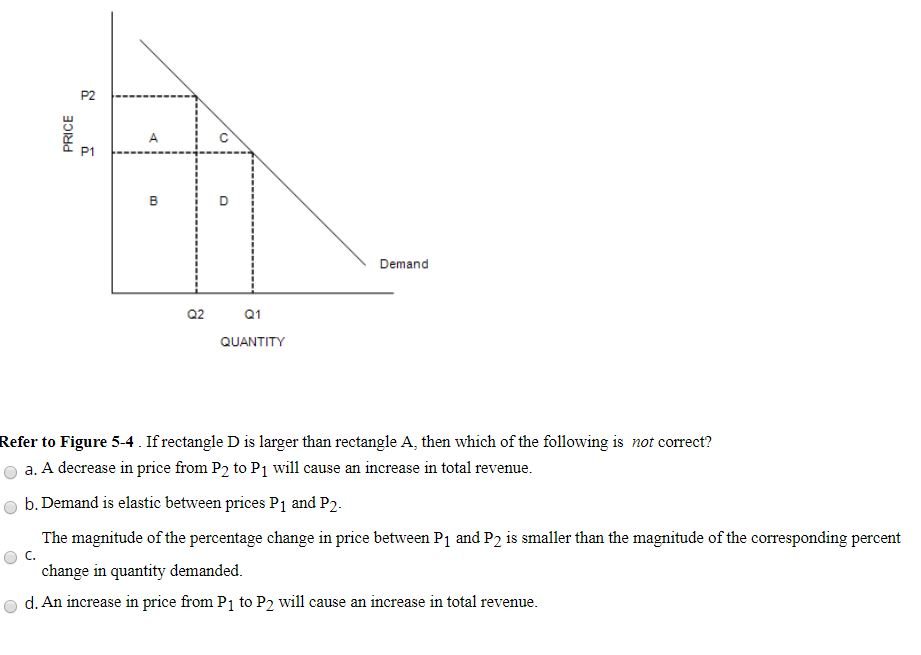36 refer to the diagram. if price falls from p1 to p2, total revenue will become area(s)
refer to the diagram if price Falls from P1 to P2 total revenue will become areas b + d refer to the diagram and assume that price increases from $2 to $10 the coefficient of the price elasticity of supply midpoint formula relating to this price range is about Refer to the above diagram. If price falls from P1 to P2, total revenue will become area(s): B + D. Refer to the above diagram. The decline in price from P1 to P2 will: increase total revenue by D - A. Refer to the above diagram. In the P1 to P2 price range, we can say:
Refer the to above diagram. If price falls from P1 to P2 total revenue will become area(s): B + D. The demand schedules for such products as eggs, bread, and electricity tend to be: relatively price inelastic. The elasticity of demand for a product is likely to be greater:

Refer to the diagram. if price falls from p1 to p2, total revenue will become area(s)
Refer to the above diagram. If price falls from P1 to P2, total revenue will become area(s):. A. B+D. Refer the to above diagram. If price falls from P1 to P2 total revenue will become area(s): B + D. The demand schedules for such products as eggs, bread, and electricity tend to be: relatively price inelastic. refer to the above diagram. total revenue at price P1 is indicated by area(s):. A + B. refer to the above diagram. if price falls to P2 total revenue will ...
Refer to the diagram. if price falls from p1 to p2, total revenue will become area(s). If price falls from P1 to P2, total revenue will become area(s):. A. B+D. Refer to the above diagram. The decline in price from P1 to P2 will:. Refer to Figure 7-4. When the price rises from P1 to P2, which area represents the increase in producer surplus to existing producers? a. BCE b. ACF c. DEF d. ABED Figure 7-5. On the graph below, Q represents the quantity of the good and P represents the good's price. ____ 17. Refer to Figure 7-5. If the price of the good is $8.50, then ... Refer to the above diagram. This firm's average fixed costs are: ... firms to leave the industry, market supply to fall, and product price to rise. ... If price is reduced from P1 to P2, total revenue will. increase by C minus A. Refer to the above diagram. The quantitative difference between areas A and C for reducing the price from P1 to P2 ... Refer to the diagram. If price falls from P1 to P2, total revenue will become area(s) Question: 16. Refer to the diagram. If price falls from P1 to P2, total revenue will become area(s) This problem has been solved! See the answer See the answer See the answer done loading. 16. Refer to the diagram.
Refer to the above diagram. If price falls from P1 to P2, total revenue will become area(s):. A. B+D. Rating: 5 · 1 review Refer to the diagram, which is a rectangular hyperbola, that is, a curve such that each ... If price falls from P1 to P2, total revenue will become area(s). Refer to the diagram. Total revenue at price P1 is indicated by area(s): A) A + C. B) C + D. ... The decline in price from P1 to P2 will: A) increase total revenue by D - A. B) decrease total revenue by A. C) increase total revenue by B + D. D) increase total revenue by D. ... Suppose that as the price of Y falls from $2.00 to $1.90, the ... 26 Dec 2017 — Refer to the above diagram which is a rectangular hyperbola, that is, ... If price falls from P1 to P2, total revenue will become area(s):.
If price falls from P1 to P2, total revenue will become area(s):-A + C.-C + D.-B + D.-C.-B+D. Refer to the diagram and assume a single good. If the price of the good increased from $5.70 to $6.30 along D1, the price elasticity of demand along this portion of the demand curve would be: ... Refer to the diagram. If price falls from $10 to $2 ... 70. Refer to the above diagram. If price falls from P1 to P2, total revenue will become area(s): A) B + D B) C + D C) A + C D) C Answer: A. Type: G Topic: 2 E: 360 MI: 116 71. Refer to the above diagram. The decline in price from P1 to P2 will: A) increase total revenue by D. C) decrease total revenue by A. Refer to the diagram. If price falls from P1 to P2, total revenue will become area(s):. B + D. refer to the above diagram. total revenue at price P1 is indicated by area(s):. A + B. refer to the above diagram. if price falls to P2 total revenue will ...
Refer the to above diagram. If price falls from P1 to P2 total revenue will become area(s): B + D. The demand schedules for such products as eggs, bread, and electricity tend to be: relatively price inelastic.
Refer to the above diagram. If price falls from P1 to P2, total revenue will become area(s):. A. B+D.

0 Response to "36 refer to the diagram. if price falls from p1 to p2, total revenue will become area(s)"
Post a Comment